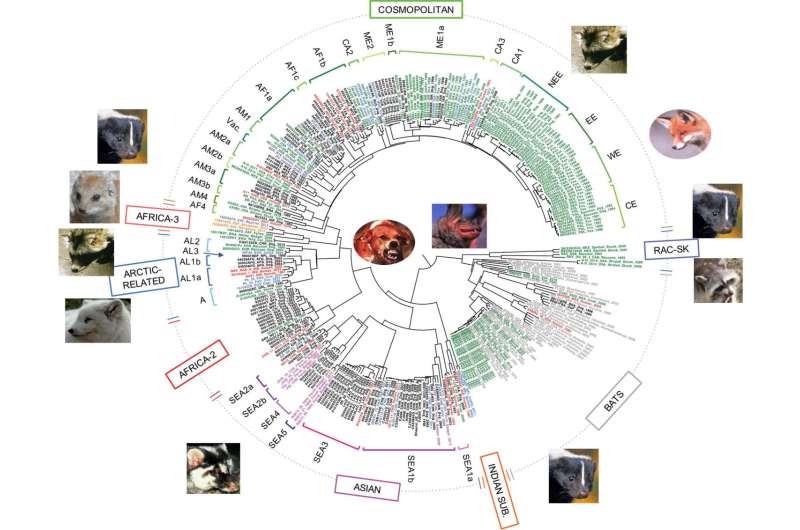Two major groups of rabies virus display distinct evolutionary trends

Using hundreds of viral genome sequences, scientists have shown that two major groups of rabies virus have unique evolutionary tendencies. Their findings are presented in a new study published in PLOS Pathogens.
Diseases that jump from other vertebrate hosts to humans are a major public health threat, but the evolutionary mechanisms behind these jumps are poorly understood. With its long history of jumping between host species, the rabies virus offers a good opportunity to identify evolutionary patterns associated with such shifts.
Cécile Troupin of Institut Pasteur, Paris, and colleagues compared 321 viral genome sequences collected from 66 countries over 65 years. The analysis revealed very different evolutionary patterns for bat-related rabies, which is found in bats and some carnivores; versus dog-related rabies, which is responsible for almost all human cases of rabies and is found in both dogs and wild carnivores.
The data suggest that different subgroups of bat-related rabies do not evolve uniformly, but dog-related rabies usually evolves at a steady rate. For dog-related rabies, host jumping was linked to multiple evolutionary patterns, such as parallel changes in amino acid sequences between different host species. The data also suggest that dog-related rabies may not need to evolve much to jump to new carnivore hosts.
Looking deeper into dog-related rabies, the scientists found evidence to suggest that, after trade between continents began in the 15th century, dog-related rabies rapidly spread worldwide. The authors say that the particular combination of species currently infected by dog-related rabies probably arose as a combined effect of historical spread by humans and host jumping.
"The data indicate that different subgroups of bat-related rabies do not evolve uniformly, but dog-related rabies usually evolves at a steady rate," the authors explain. "For dog-related rabies, host jumping was linked to multiple evolutionary patterns, such as parallel changes in amino acid sequences between different host species, suggesting that dog-related rabies may not need to evolve much to jump to new carnivore hosts."
More information: Troupin C, Dacheux L, Tanguy M, Sabeta C, Blanc H, Bouchier C, et al. (2016) Large-Scale Phylogenomic Analysis Reveals the Complex Evolutionary History of Rabies Virus in Multiple Carnivore Hosts. PLoS Pathog 12(12): e1006041. DOI: 10.1371/journal.ppat.1006041
Journal information: PLoS Pathogens
Provided by Public Library of Science
















